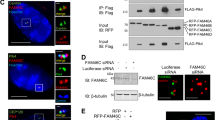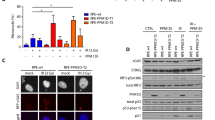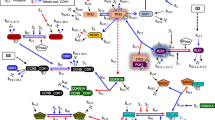Abstract
The four mammalian polo-like kinase (Plk) family members are critical regulators of cell cycle progression, mitosis, cytokinesis, and the DNA damage response. Research conducted to date has primarily investigated the expression patterns, structural features, substrates, and subcellular distribution of these important serine-threonine kinases. Here, we review the published data describing the regulation of Plk1, 2, 3, or 4 gene expression either during mammalian cell cycle progression or in tissue samples. These studies have demonstrated that the Plk family genes are differentially expressed following growth factor stimulation of quiescent fibroblasts. Furthermore, although Plk1 and Plk2 mRNA and protein levels are coordinately regulated during cell cycle progression, this is not the case for Plk3. In addition, the Plk1, 2 and 4 proteins have relatively short intracellular half-lives, but Plk3 is very stable. The Plk family genes are also differentially regulated in stressed cells; for example, when DNA-damaging agents are added to cycling cells, Plk1 expression decreases, but Plk2 and Plk3 expression increases. Finally, Plk1, 2, 3, and 4 are expressed to varying degrees in different human tissue types and it has been reported that Plk1 expression is increased and Plk3 expression is decreased in tumor specimens. These results indicate that the differential regulation of Plk family member gene expression is one cellular strategy for controlling Plk activity in mammalian cells.
This is a preview of subscription content, access via your institution
Access options
Subscribe to this journal
Receive 50 print issues and online access
$259.00 per year
only $5.18 per issue
Buy this article
- Purchase on SpringerLink
- Instant access to full article PDF
Prices may be subject to local taxes which are calculated during checkout



Similar content being viewed by others
References
Alberts GF and Winkles JA . (2004). Cell Cycle, 3, 678–684.
Alvarez B, Martinez A, Burgering BM and Carrera AC . (2001). Nature, 413, 744–747.
Ando K, Ozaki T, Yamamoto H, Furuya K, Hosoda M, Hayashi S, Fukuzawa M and Nakagawara A . (2004). J. Biol. Chem., 279, 25549–25561.
Anger M, Kues WA, Klima J, Mielenz M, Kubelka M, Motlik J, Esner M, Dvorak P, Carnwath JW and Niemann H . (2003). Mol. Reprod. Dev., 65, 245–253.
Bahassi EM, Conn CW, Myer DL, Hennigan RF, McGowan CH, Sanchez Y and Stambrook PJ . (2002). Oncogene, 21, 6633–6640.
Barr FA, Sillje HH and Nigg EA . (2004). Nat. Rev. Mol. Cell. Biol., 5, 429–441.
Blank M, Mandel M, Keisari Y, Meruelo D and Lavie G . (2003). Cancer Res., 63, 8241–8247.
Burns TF, Fei P, Scata KA, Dicker DT and El Deiry WS . (2003). Mol. Cell. Biol., 23, 5556–5571.
Chase D, Yang F, Hanshew B, Winkles JA, Longo DL and Ferris DK . (1998). Biochem. J., 333, 655–660.
Clay FJ, McEwen SJ, Bertoncello I, Wilks AF and Dunn AR . (1993). Proc. Natl. Acad. Sci. USA, 90, 4882–4886.
Dai W, Li Y, Ouyang B, Pan H, Reissmann P, Li J, Wiest J, Stambrook P, Gluckman JL, Noffsinger A and Bejarano P . (2000). Genes Chromosome Cancer, 27, 332–336.
Dai W, Liu T, Wang Q, Rao CV and Reddy BS . (2002a). Int. J. Oncol., 20, 121–126.
Dai W, Wang Q and Traganos F . (2002b). Oncogene, 21, 6195–6200.
Dietzmann K, Kirches E and Mawrin C . (2002). J. Cancer Res. Clin. Oncol., 128, 265–270.
Donaldson MM, Tavares AA, Hagan IM, Nigg EA and Glover DM . (2001). J. Cell Sci., 114, 2357–2358.
Donohue PJ, Alberts GF, Guo Y and Winkles JA . (1995). J. Biol. Chem., 270, 10351–10357.
Ferris DK, Maloid SC and Li CC . (1998). Biochem. Biophys. Res. Commun., 252, 340–344.
Fode C, Binkert C and Dennis JW . (1996). Mol. Cell. Biol., 16, 4665–4672.
Fode C, Motro B, Yousefi S, Heffernan M and Dennis JW . (1994). Proc. Natl. Acad. Sci. USA, 91, 6388–6392.
Georgescu SP, Komuro I, Hiroi Y, Mizuno T, Kudoh S, Yamazaki T and Yazaki Y . (1997). J. Mol. Cell. Cardiol., 29, 929–937.
Glover DM, Hagan IM and Tavares AA . (1998). Genes Dev., 12, 3777–3787.
Golsteyn RM, Mundt KE, Fry AM and Nigg EA . (1995). J. Cell Biol., 129, 1617–1628.
Golsteyn RM, Schultz SJ, Bartek J, Ziemiecki A, Ried T and Nigg EA . (1994). J. Cell Sci., 107, 1509–1517.
Hamanaka R, Maloid S, Smith MR, O'Connell CD, Longo DL and Ferris DK . (1994). Cell Growth Differ., 5, 249–257.
Hamanaka R, Smith MR, O'Connor PM, Maloid S, Mihalic K, Spivak JL, Longo DL and Ferris DK . (1995). J. Biol. Chem., 270, 21086–21091.
Harris PL, Zhu X, Pamies C, Rottkamp CA, Ghanbari HA, McShea A, Feng Y, Ferris DK and Smith MA . (2000). Neurobiol. Aging, 21, 837–841.
***Holtrich U, Wolf G, Brauninger A, Karn T, Bohme B, Rubsamen-Waigmann H and Strebhardt K . (1994). Proc. Natl. Acad. Sci. USA, 91, 1736–1740.
Holtrich U, Wolf G, Yuan J, Bereiter-Hahn J, Karn T, Weiler M, Kauselmann G, Rehli M, Andreesen R, Kaufmann M, Kuhl D and Strebhardt K . (2000). Oncogene, 19, 4832–4839.
Hudson JW, Kozarova A, Cheung P, Macmillan JC, Swallow CJ, Cross JC and Dennis JW . (2001). Curr. Biol., 11, 441–446.
Karn T, Holtrich U, Wolf G, Hock B, Strebhardt K and Rubsamen-Waigmann H . (1997). Oncol. Reports, 4, 505–510.
Kauselmann G, Weiler M, Wulff P, Jessberger S, Konietzko U, Scafidi J, Staubli U, Bereiter-Hahn J, Strebhardt K and Kuhl D . (1999). EMBO J., 18, 5528–5539.
Knecht R, Elez R, Oechler M, Solbach C, von Ilberg C and Strebhardt K . (1999). Cancer Res., 59, 2794–2797.
Knecht R, Oberhauser C and Strebhardt K . (2000). Int. J. Cancer, 89, 535–536.
Kotani S, Tanaka H, Yasuda H and Todokoro K . (1999). J. Cell Biol., 146, 791–800.
Lake RJ and Jelinek WR . (1993). Mol. Cell. Biol., 13, 7793–7801.
Lee KS, Yuan YO, Kuriyama R and Erikson RL . (1995). Mol. Cell. Biol., 15, 7143–7151.
Li B, Ouyang B, Pan H, Reissmann PT, Slamon DJ, Arceci R, Lu L and Dai W . (1996). J. Biol. Chem., 271, 19402–19408.
Liby K, Wu H, Ouyang B, Wu S, Chen J and Dai W . (2001). DNA Sequence, 11, 527–533.
Lindon C and Pines J . (2004). J. Cell Biol., 164, 233–241.
Ma S, Charron J and Erikson RL . (2003a). Mol. Cell. Biol., 23, 6936–6943.
Ma S, Liu MA, Yuan YL and Erikson RL . (2003b). Mol. Cancer Res., 1, 376–384.
Matsubara N, Yanagisawa M, Nishimune Y, Obinata M and Matsui Y . (1995). Mol. Reprod. Dev., 41, 407–415.
Rechsteiner M and Rogers SW . (1996). Trends Biochem. Sci., 21, 267–271.
Ree AH, Bratland A, Nome RV, Stokke T and Fodstad O . (2003). Oncogene, 22, 8952–8955.
Roshak AK, Capper EA, Imburgia C, Fornwald J, Scott G and Marshall LA . (2000). Cell Signal., 12, 405–411.
Ryan KM, Phillips AC and Vousden KH . (2001). Curr. Opin. Cell Biol., 13, 332–337.
Schlessinger J . (2000). Cell, 103, 211–225.
Shimizu-Yoshida Y, Sugiyama K, Rogounovitch T, Ohtsuru A, Namba H, Saenko V and Yamashita S . (2001). Biochem. Biophys. Res. Commun., 289, 491–498.
Simizu S and Osada H . (2000). Nat. Cell Biol., 2, 852–854.
Simmons DL, Neel BG, Stevens R, Evett G and Erikson RL . (1992). Mol. Cell. Biol., 12, 4164–4169.
Strebhardt K, Kneisel L, Linhart C, Bernd A and Kaufmann R . (2000). JAMA, 283, 479–480.
Syed V and Hecht NB . (1998). Endocrinology, 139, 3503–3511.
Takai N, Miyazaki T, Fujisawa K, Nasu K, Hamanaka R and Miyakawa I . (2001). Cancer Lett., 164, 41–49.
Takai N, Yoshimatsu J, Nishida Y, Narahara H, Miyakawa I and Hamanaka R . (1999). Reprod. Fertil. Dev., 11, 31–35.
Tokumitsu Y, Mori M, Tanaka S, Akazawa K, Nakano S and Niho Y . (1999). Int. J. Oncol., 15, 687–692.
Uchiumi T, Longo DL and Ferris DK . (1997). J. Biol. Chem., 272, 9166–9174.
Waelput W, Verhee A, Broekaert D, Eyckerman S, Vandekerckhove J, Beattie JH and Tavernier J . (2000). Biochem. J., 348, 55–61.
Weichert W, Denkert C, Schmidt M, Gekeler V, Wolf G, Kobel M, Dietel M and Hauptmann S . (2004). Br. J. Cancer, 90, 815–821.
Wikman H, Kettunen E, Seppanen JK, Karjalainen A, Hollmen J, Anttila S and Knuutila S . (2002). Oncogene, 21, 5804–5813.
Winkles JA . (1998). Prog. Nucleic Acid Res. Mol. Biol., 58, 41–78.
Wolf G, Elez R, Doermer A, Holtrich U, Ackermann H, Stutte HJ, Altmannsberger HM, Rubsamen-Waigmann H and Strebhardt K . (1997). Oncogene, 14, 543–549.
Wolf G, Hildenbrand R, Schwar C, Grobholz R, Kaufmann M, Stutte HJ, Strebhardt K and Bleyl U . (2000). Pathol. Res. Pract., 196, 753–759.
Yamashita Y, Kajigaya S, Yoshida K, Ueno S, Ota J, Ohmine K, Ueda M, Miyazato A, Ohya K, Kitamura T, Ozawa K and Mano H . (2001). J. Biol. Chem., 276, 39012–39020.
Yoshimatsu J, Takai N, Yoshimatsu Y, Narahara H, Miyakawa I and Hamanaka R . (1999). Res. Commun. Mol. Pathol. Pharmacol., 106, 3–12.
Yuan J, Horlin A, Hock B, Stutte HJ, Rubsamen-Waigmann H and Strebhardt K . (1997). Am. J. Pathol., 150, 1165–1172.
Zuber J, Tchernitsa OI, Hinzmann B, Schmitz A, Grips M, Hellriegel M, Sers C, Rosenthal A and Schafer R . (2000). Nat. Genet., 24, 144–152.
Acknowledgements
Plk3 studies in the author's laboratory are supported in part by National Institutes of Health Grant HL-67051.
Author information
Authors and Affiliations
Corresponding author
Rights and permissions
About this article
Cite this article
Winkles, J., Alberts, G. Differential regulation of polo-like kinase 1, 2, 3, and 4 gene expression in mammalian cells and tissues. Oncogene 24, 260–266 (2005). https://doi.org/10.1038/sj.onc.1208219
Published:
Issue Date:
DOI: https://doi.org/10.1038/sj.onc.1208219
Keywords
This article is cited by
-
Development of hyaluronic acid–anchored polycaprolactone nanoparticles for efficient delivery of PLK1 siRNA to breast cancer
Drug Delivery and Translational Research (2023)
-
PLK1 promotes proliferation and suppresses apoptosis of renal cell carcinoma cells by phosphorylating MCM3
Cancer Gene Therapy (2020)
-
A homozygous G insertion in MPLKIP leads to TTDN1 with the hypergonadotropic hypogonadism symptom
BMC Medical Genetics (2018)
-
Targeting PLK1 overcomes T-DM1 resistance via CDK1-dependent phosphorylation and inactivation of Bcl-2/xL in HER2-positive breast cancer
Oncogene (2018)
-
PLK1-associated microRNAs are correlated with pediatric medulloblastoma prognosis
Child's Nervous System (2017)



